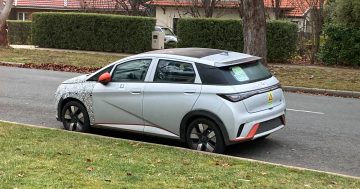
Local families can help develop the smart car of the future. Photo: File.
The tech to run the smart car of the future is being developed right here in Canberra, and local families can contribute to the artificial intelligence research that will mean safer and more responsive vehicles.
Pioneering Canberra technology firm Seeing Machines is an industry leader in vision-based monitoring technology that enable machines to see, understand and assist people, and its camera-based Driver Monitoring Systems (DMS) are being used to enhance vehicle safety around the world.
It is now developing new software that in just four or five years will be part of new safety features that will be required by car makers and regulators, as well as being part of fully integrated monitoring systems in the next wave of vehicles coming our way, whether they are are internal combustion engine, electric or autonomous.
Seeing Machines is seeking to recruit Canberra families with at least one child who occupies a capsule, car-seat or booster seat, and their vehicles to train AI algorithms to refine its Seat Occupancy Detection feature, which detects whether a seat is occupied or empty and identifies it as a human or an object.
This is key to enhancing safety features such as seatbelt use and the safer deployment of airbags.
During one-hour sessions at the company’s Fyshwick headquarters, families will be asked to sit in their vehicle and follow some simple directions, as naturally as possible, such as picking up an object or looking in a certain direction.
Seeing Machines CEO Paul McGlone said the aim is to collect a range of data on some specific actions that could then be codified into algorithms and converted into software to develop a product.
“It’s a really important program,” he said. “The folks who will be participating in this will, most likely in four years time, be purchasing a car that tracks the exact actions we’re asking them to demonstrate during the next few weeks.”
The new software and the integration of vision, voice and external radar systems also means current sensors in cars will no longer be needed, leading to lower costs for car makers.
Mr McGlone said it also will open up a range of new safety features.
“If you look at size, weight and body mass through a camera-based system, this technology today can enable the adjustment of the airbag trigger to ensure the airbag is being executed at the point of accident based on who is sitting in the seat,” he said.
It will also lead to drivers being able to use their eyes to initiate actions without touching any buttons, and rear-vision mirrors automatically adjusting based on the position of the driver’s eyes.
Mr McGlone said the program is a local initiative because Canberra is where the company, which turns 21 this year, is based and where most of its researchers live.
The next phase of the development’s value to the company will “in the long run be very, very substantial” as demand soars.
“The market we’re in is at an absolute flexion point – it’s exploding,” he said. “Every car maker in the world is now tendering for driver-based monitoring systems.”
The company is looking to start the COVID-19 safe program as soon as possible, and it will last from six to eight weeks, possibly repeating from time to time.
“We’re trying to get the same thing done in as many different ways with as many different people as possible,” said Mr McGlone.
A range of daily timeslots are available and can be changed to suit volunteers. Participating families will receive a $200 shopping voucher that can be used at a wide range of retail outlets.
If you’re interested in participating, email DataAcquisitionTeam@SeeingMachines.com.














